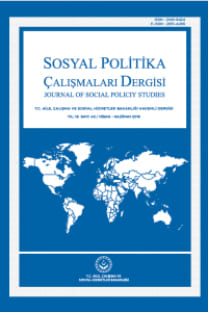Menopoz ve Hormon Replasman Tedavisi İle İlgili Kanıta Dayalı Çalışmalar
Bu makalenin amacı menopozla ilgili semptomları rahatlatmada yaygın olarak kullanılan hormon replasman tedavisinin yararları ve zararlarına ilişkin kanıta dayalı çalışmaları incelemektir.Menopoz, Dünya Sağlık Örgütü’nün (DSÖ) önerdiği tanıma göre, “ovaryum aktivitesinin yitirilmesi sonucunda menstruasyonun kalıcı olarak sonlanmasıdır”. Hormon replasman tedavisinin amacı östrojene yanıt veren dokulardaki etkileri geriye çevirerek menopoz sonrası kadının yaşam kalitesini korumaktır. Halen dünyada milyonlarca postmenapozal kadın hormon tedavisi olarak östrojen kullanmaktadır. Hormon replasman tedavisinde progesteronların kullanım amacı, östrojenin endometriumdaki etkilerini karşılamaktır. Yapılan meta-analizler, sistematik araştırmalar ve randomize kontrollü çalışmalarda östrojenin vazomotor semptomların sıklığı ve şiddetinde azalma, ürogenital semptomlarda hafifleme, depresyon durumunda azalma ve yaşam kalitesinde gelişme sağladığı saptanmıştır. Uyku bozukluğu ile ilgili farklı östrojen preparatları kullanılarak yapılan çalışmalardan bazılarında östrojenin etkili olduğu belirtilirken bazılarında da etkili olmadığı saptanmıştır. Bununla birlikte, bilinen sağlık riskleri ve uzun dönem kullanımına ilişkin belirsizlikler vardır.
Anahtar Kelimeler:
Menopoz, hormon replasman tedavisi, kanıta dayalı çalışmalar
Evidence Based Studies Related to Menopause and Hormone Replacement Therapy
The purpose of this article is to presented evidencebased studies related to benefits and damages of hormone replacement therapy used commonly in relieving symptoms regarding menopauseMenopause, according to definition which commonly using and suggested of World Health Organization (WHO), is terminated permanently menstruationas a result of lost of ovarium activity. Purpose of hormonal replasman therapy (HRT) is to protect life quality of woman postmenopase by reversing effects in tissues that respond to oestrogen. Currently, millions of postmenopausal women have used oestrogen as hormone therapy in the world. The purpose of using of progesterones in hormone replacement therapy have correspond effects on endometrium . It is determined by meta-analysis systematic reviews of ostregen and randomizedcontrol trials that oestrogen has provided decline on incidence and intensity of vasomotor symptoms, lighten on genitourinary symptoms, decline on depression and improvement on quality of life It is also determined that oestregen is found efficent related to sleep disorder in some studies but in other studies not by using different oestrogen preparates. However there are known health risks and uncertainties related to long time use.
Keywords:
Menopause, hormonal replasman therapy, evidence-based studies,
___
- AL-AZZAWİ, F., BUCKLER, H.M. (2003). Comparison of a novel vaginal ring delivering estradiol acetate versus oral estradiol forrelief of vasomotor meno- pausal symptoms, Climacteric, 6(2):118-27.
- AYTON, R.A., DARLİNG, G.M., MURKİES, A.L. et al. (1996). A comparative study of safety and effi- cacy of continuous low dose oestradiol released from a vaginal ring compared with conjugated equine oestrogen vaginal cream in the treatment of postmenopausal urogenital atrophy, Br J Obs- tet Gynaecol, 103(4):351-8.
- BACHMANN, G., NOTELOVİTZ, M., NACHTİGALL, L. et al. (1997). A comparative study of a low-dose estradiol vaginal ring and conjugated estrogen cream for postmenopausal urogenital atrophy, Primary Care Update for Ob/Gyns, 4(3):109- 115.
- BARRETT-CONNOR, E., HENDRIX, S., ETTİNGER, B. (2002). Best Clinical Practices from the International Paper on Women’s Health and Menopause: A Compprehensive Approach, National Heart, Lung, and Blood Institute Office of Research on Women’s Health National Insti
- SOARES CN, ALMEIDA OP, JOFFE H et al. (2001). Ef- ficacy of estradiol for the treatment of depressive disorders in perimenopausal women: A double- blind, randomized, placebo-controlled trial, Arch Gen Psychiatry, 58(6):529-34.
- SPEROFF, L. (2003). Efficacy and tolerability of a no- vel estradiol vaginal ring for relief of menopausal symptoms, Obstet Gynecol, 102:823-34.
- STRİCKLER, R., STOVALL, D.W., MERRİTT, D. et al. (2000). Raloxifene and estrogen effects on qu- ality of life in healthy postmenopausal women: a placebo-controlled randomized trial, Obstet Gy- naecol, 96(3):359-65.
- TIRAŞ, B., KURDOĞLU, M. (2004). “Postmenopozal Hormon Replasman Tedavisinde Güncel Yakla- şımlar”, Sted,13(9): 332-334.
- ÜNLÜER, E. (2005). Postmenopozal kadınlarda yılan otu tedavisinin vasküler elastisite, kan lipid pro- fili ve vazomotor semptomlar üzerine etkilerinin araştırılması”, Sağlık Bakanlığı Bakırköy Kadın ve Çocuk Hastalıkları Eğitim ve Araştırma Has- tanesi, Uzmanlık Tezi, İstanbul.
- VOSS, S., QUAIL, D., DAWSON, A. et al. (2002). A ran- domised, doubleblind trial comparing raloxifene HCl and continuous combined hormone repla- cement therapy in postmenopausal women: ef- fects on compliance and quality of life, BJOG, 109(8):874-85.
- WILKLUND, I., KARLBERG, J., MATTSSON, L.A. (1993). Quality of life of postmenopausal women on a regimen of transdermal estradiol therapy: a double-blind placebo-controlled study, Am J Obstet Gynecol, 168:824-30.
- YÜCESOY, İ., ÇAKIROĞLU, Y. Menopoz ve Postme- nopoz. Klinikte Obstetrik ve Jinekoloji, Ed: ÇİÇEK N., MUNGAN T., Güneş Tıp Kitabevleri, Ankara 2007.
- complaints, Maturitas, 36(2):123-30.
- ISSN: 2148-9424
- Yayın Aralığı: Yılda 4 Sayı
- Başlangıç: 2012
- Yayıncı: Aile,Çalışma ve Sosyal Hizmetler Bakanlığı
Sayıdaki Diğer Makaleler
Öğr. Gör. Nesrin İLHAN, Yard. Doç. Dr. Ayşe ERGÜN
Montessori Metodunda Okuma ve Yazma Eğitimi
Bir Fedakâkarlık Örneği Olarak "Kan Bağışı"
Prof. Dr. Şengül HABLEMİTOĞLU, Doç. Dr. Yasemin ÖZKAN, Uzm. Filiz YILDIRIM
Menopoz ve Hormon Replasman Tedavisi İle İlgili Kanıta Dayalı Çalışmalar
Arş. Gör. Emine ŞEN, Yard. Doç. Dr. Aynur SARUHAN
Bir Fedakâkarlık Örneği Olarak "Kan Bağışı"
Prof. Dr. Şengül HABLEMİTOĞLU, Doç. Dr. Yasemin ÖZKAN, Uzm. Filiz YILDIRIM
Ergenlik Döneminde İlişkiler: Akran ve Romantik İlişkilere Genel Bakış
